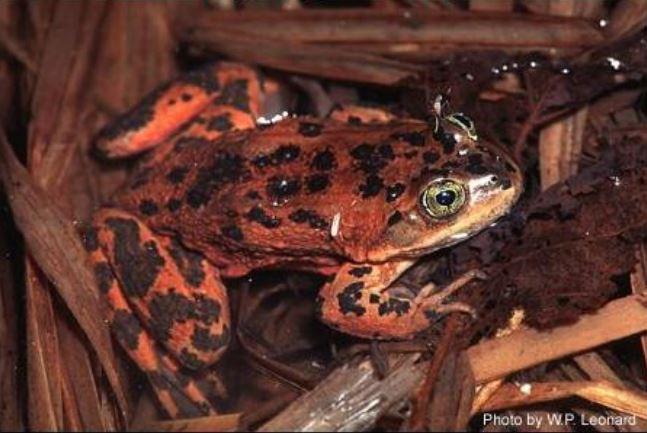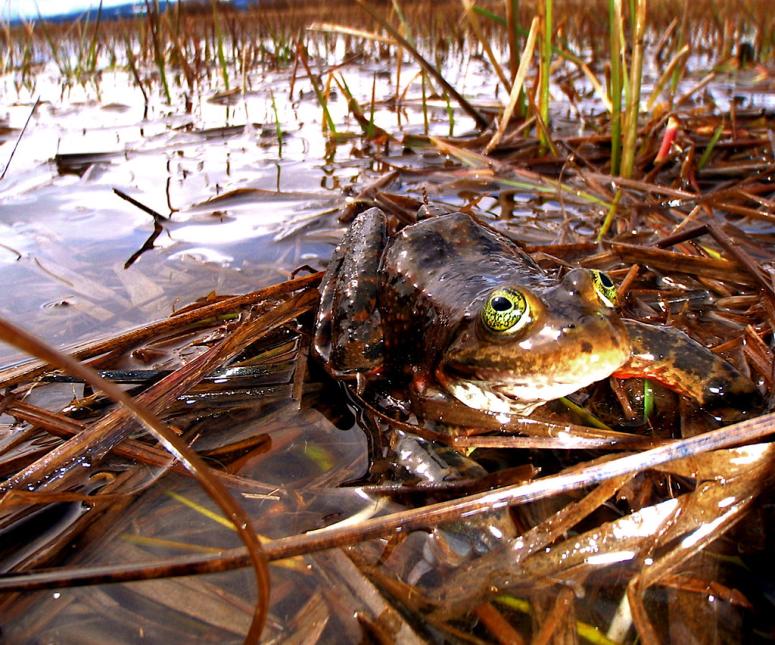Moderate-
High
The Washington conservation status of this frog is based on its rarity in the state, primarily due to human-stressors causing loss or degradation of wetland, creek, and river habitats.
NOTE: if submitting photos of this species. it is helpful to include photos of the topside, underside, and sideview with legs extended to show the groin, plus the frog’s face and hind foot webbing.
Description and Range
Physical description
The Oregon spotted frog is a medium to large aquatic frog (adults are 2 to 4 inches in length from snout to vent). The dorsal color is olive brown to brick red, with black spots that have ragged edges and light centers. The undersides of the legs and margin of the abdomen are orange-red to red (absent in newly metamorphosed frogs and small juveniles). The legs are relatively short, and the toes are nearly fully webbed. Breeding males develop large forelimbs and thumb bases and have a dark nuptial pad on each thumb.
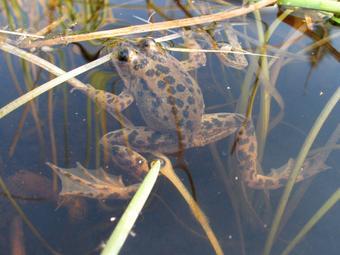
Native True Frogs (Rana species) in Washington have dorsolateral folds (unlike other Washington anurans) and are similar in appearance. The Oregon spotted frog and Columbia spotted frog species have subtle color variations but are morphologically indistinct (they were distinguished as separate species by genetic analysis) and may be separated by geographic locality.
The following traits distinguish the Oregon spotted frog from the Cascades frog and northern red-legged frog: 1) the dorsal spots are black with ragged edges and light centers, 2) the eyes are oriented upward at roughly a 45-degree angle with the entire pupil of both eyes visible when the frog is viewed directly from above, 3) there is nearly full webbing between the toes with the webbing of the hind foot reaching almost to the tip of the longest toe and the webbing is almost straight when the toes are stretched apart, 4) the coloration in the groin area is similar to the coloration anteriorly on the side and posteriorly on the thighs with no obvious yellow and black mottled patch or patches, 5) when the hind leg is pressed forward against the body, the heel of the hind foot will seldom reach the nostril (similarly, the knee to heel measurement is typically less than half of the snout-vent length), 6) the dorsolateral folds are interrupted about two-thirds the distance down the back from the eye and often disappear entirely posteriorly, and 7) Cascade frogs have honey-colored and yellow undersides, not red. The above traits may be difficult to see or absent in small juvenile frogs.
American bullfrogs, a common non-native species, have a distinct fold from the posterior edge of the eye, around the top of the tympanum and ending at the arm and they lack dorsolateral folds.
Larvae
The tadpole (aquatic larval stage) has an oval body with dorsal eyes, a vent on the right side, a spiracle on the left side and a dorsal fin that originates on the body near the dorsal tail-body junction. The tip of the tail is pointed. At hatching, the tadpoles appear black, have long tails (greater than 1.5 times body length), obvious gills and remain associated with the egg mass for days. As the tadpoles grow, the ground color and belly lighten and silver flecks appear, eventually covering the gut. Tadpoles can grow to large sizes (4 inches total length) before metamorphosis.
In general, it is difficult to distinguish the tadpoles of the Oregon spotted frog from those of the Cascades frog and northern red-legged frog. Larger tadpoles (those greater than 2 inches total length) of the Oregon spotted frog have a tail length to body length ratio of 2.7 whereas Cascades frog and northern red-legged frog have a tail length to body length ratio 2.6 or smaller. This criterion can only be used if the tail is undamaged.
American bullfrog and American green frog tadpoles are also similar but larger tadpoles have distinct black spots over a typically khaki-colored body and tail and the abdomen is opaque and lacks pigments with a metallic quality.
Eggs
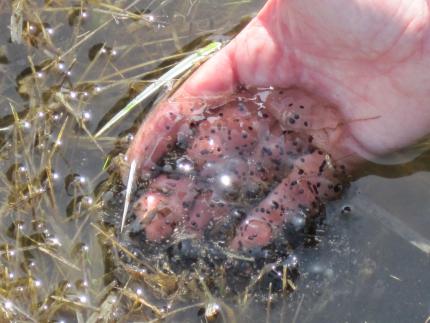
Individual egg masses are globular, loose to the touch, grapefruit-sized and not attached to a vegetation brace, although they may stick to the vegetation under the egg masses. The eggs and larvae appear black (but are actually dark brown). The frogs lay the egg masses at water body margins in water usually less than 6 inches deep. The top of the egg mass is often exposed at the water surface. Egg masses are typically communally laid, resulting in clustered egg mass groups of two to more than 100. Single egg masses in the vicinity of multi-mass clusters are common.
The communal egg masses of the Oregon spotted frog and Cascades frog cannot be easily distinguished. Northern red-legged frogs do not lay egg masses in communal overlapping clusters, although they may be closely spaced if the vegetation braces to which the egg masses are attached are close together; rather they attach egg masses to vegetation individually in water that is usually over 10 inches deep.
The northwestern salamander has a grapefruit-sized globular egg mass, but its jelly is solid to the touch, always attached to vegetation or woody debris and the eggs and larvae are brown not black. No other species that occur in the same range and habitat have large globular egg masses.
Voice
The call of the Oregon spotted frog is a series of six to nine low-pitched clucks similar to the sound made when the tongue is clicked against the roof of the mouth. One must typically be within 16 feet to hear this faint call.
For more details about the Oregon spotted frog, see the Washington Herp Atlas (PDF).
Ecology and life history
This species is highly aquatic and rarely found away from water. Extant populations occur in large shallow wetland systems associated with a stream or stream network. Breeding habitat is in seasonally flooded margins of wetlands and areas of extensive shallows (approximately 6 to 8 inches deep).
Waters that remain aerobic and do not freeze to the sediments are necessary for winter survival in areas subject to freezing. Beaver impounded systems appear to provide many of the habitat requirements of this species. Radio-telemetry and mark-recapture studies have revealed that Oregon spotted frogs are relatively sedentary during the summer (driest period) and remain active underwater during the winter.
Oregon spotted frogs eat mostly insects. Tadpoles eat algae and detritus (organic material) in the aquatic environment.
These frogs are communal breeders that return to the same breeding areas each year. They require breeding sites in shallow water with short vegetation and full sun exposure. This habitat type is rapidly lost to invasive grasses without management such as grazing, haying, mowing or restoration to native flora.
Breeding occurs in February and March, and times can differ depending on location, elevation, and water temperatures. Egg masses are placed in areas where they receive little or no shading from vegetation. Embryos take approximately three weeks to develop to hatching. Tadpoles transform in mid-summer of their first year.
Oregon spotted frogs are preyed upon my many predators that live in wetlands, such as great blue herons and mink. Of particular concern are non-native predators such as American bullfrogs and warm-water game fish.
Geographic range
The historical range for Oregon spotted frogs in Washington is the Puget Trough Ecoregion, in Whatcom, Skagit, and Thurston counties, and the southern extent of the Eastern Cascades Ecoregion, in Skamania and Klickitat counties.
Current occurrences are in the following watersheds: Sumas River, South Fork Nooksack River, Samish River, upper Black River, lower Trout Lake Creek and at Conboy Lake and Camas Prairie in the Outlet Creek drainage. Within a watershed, most breeding populations are small and many are isolated from other breeding populations.
This map from the Washington Herp Atlas illustrates the distribution of Oregon spotted frog in Washington based on records in the WDFW database as of 2016. If you see this species in areas that are not indicated on the map or have more recent observations (less than 10 years), please share your observation using the WDFW wildlife reporting form.
For maps of range-wide distribution and conservation status of this species, check out NatureServe Explorer and the International Union for Conservation of Nature Red List.
Climate vulnerability
Sensitivity to climate change
Moderate-
High
Very limited information is available regarding the sensitivity of the Oregon spotted frog to climate change. Its main sensitivity is likely to be due to changes in pond and wetland habitat. This species is a warmer water marsh specialist that prefers shallow water ponds and vegetated pools connected to permanent water for breeding and tadpole development. Potential warmer and drier conditions could lead to alterations in or disappearance of shallow ponds and changes in vegetation, which could impact breeding and tadpole survival. In particular, it is likely to seasonally concentrate predators to a greater extent, and if those predators are warmwater exotics, it will increase the likelihood of predation on Oregon spotted frog life stages. Additionally, warmer temperatures could lead to increases in invasive warm water predators that prey upon Oregon spotted frogs, like bullfrogs and some invasive fish species, thus leading to potential population declines. Warmer temperature will also increase the active season for bullfrogs, which will reduce the time bullfrogs require to reach large body sizes, a situation that currently limits them somewhat in most areas of the Pacific Northwest. Increase bullfrog body size is likely to put the entire size distribution of post-metamorphic Oregon spotted frogs at risk.
Exposure to climate change
Moderate
- Increased temperatures
- Changes in precipitation
- Altered hydrology >Increased temperature result in greater ecological release of exotics
Regulations
Licenses and permits
Be advised that collection of this species is only permitted under a WDFW Scientific Collection Permit for research and educational activities.
Rules and seasons
Oregon spotted frogs are classified as an endangered species in Washington. The law protects endangered species and prohibits them from being hunted, taken maliciously, harassed, or possessed. This is for all life stages including adults, juveniles, tadpoles, and eggs. Keeping this species as a pet in Washington is also prohibited because species native to the state cannot be kept in captivity. The only exceptions are for zoos, educational centers, rehabilitation facilities, and research facilities that receive permits from WDFW.
Conservation
Conservation Threats and Actions Needed
- Resource information collection needs
- Threat: Lack of information on status and distribution.
- Action Needed: Inventory areas that might still support this species and monitor known populations.
- Invasive and other problematic species
- Threat: Invasive reed canarygrass. Oregon spotted frog oviposition habitat is located in seasonally flooded, shallow water (less than 6 inches), with short vegetation and full sun exposure. Reed canarygrass is invasive, has a dense growth, pattern and grows to over 5 feet tall.
- Action Needed: Manage reed canarygrass either by keeping it short (mowing, haying, livestock grazing) or remove it.
- Threat: Lack of disturbance to wetlands. Oregon spotted frog oviposition habitat is located in seasonally flooded, shallow water (less than 6 inches), with short vegetation and full sun exposure. This is typical of early successional wetland plant growth.
- Action Needed: Create or mimic disturbance processes at sites occupied by Oregon spotted frogs. Examples include introducing beaver, use of fire, mowing, haying and/or grazing.
- Threat: Non-native predatory fish and American bullfrogs. These species prey on Oregon spotted frogs.
- Action Needed: Prevent non-native predatory fish and American bullfrogs from establishing populations at Oregon spotted frog occupied sites.
- Climate change and severe weather (See the Climate vulnerability section for more details about the threats that climate change pose to this species)
- Threat: Drying of aquatic habitats occupied by Oregon spotted frog and subsequent changes to vegetation (expansion of trees, shrubs, and reed canarygrass, etc.).
- Action Needed: Prevent drying of wetlands and streams occupied b Oregon spotted frogs. Remove and manage trees, shrubs, and reed canarygrass in breeding habitat.
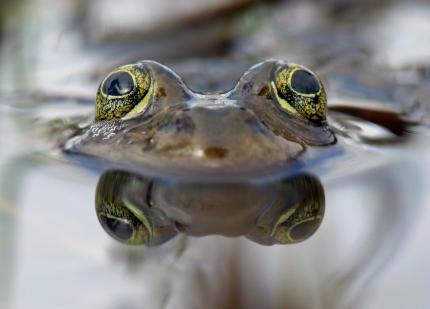
Our Conservation Efforts
Protecting the Oregon Spotted Frog in Washington
The WDFW partners with U.S. Fish and Wildlife Service and Washington Department of Natural Resources to protect the Oregon spotted frog in Washington. Watch this video to learn about various conservation efforts aimed at saving this species. See biologists conduct frog egg mass counts to get an idea of the number of breeding adults at a location and to better understand habitat use. Learn why habitat restoration for this species is important not only on public lands but on private lands, too, with the cooperation of private landowners who actively manage their property to help preserve this rare frog.
If you are a landowner with property in Clark, Pierce, King, Klickitat, Skagit, Snohomish, Thurston or Whatcom County and want to help with frog recovery efforts, please contact us: (360) 902-2515 or email: wildthing@dfw.wa.gov, and ask about cooperative conservation programs that provide incentives to private landowners. Find more information in this downloadable brochure: Oregon Spotted Frogs Need Your Help.
Check out this video for additional information about landowners helping with the conservation of this species.
Living with wildlife
Frogs, along with salamanders and newts, are members of the animal group called amphibians. Frogs start their lives as totally aquatic larvae with gills and a pronounced tail fin; this is familiar to many people as the tadpole stage. Over time, legs develop, the tail and gills are absorbed, and the frog transforms into a terrestrial, air-breathing animal.
Learn more about living with frogs, including how to attract them or prevent conflicts.
Resources
References
Corkran, C. C. and C. Thoms. 1996. Amphibians of Oregon, Washington and British Columbia. Lone Pine, Redmond, Washington. 175 pp.
Green, D. M., H. Kaiser, T. F. Sharbel, J. Kearsley, and K.R. McAllister. 1997. Cryptic species of spotted frogs Rana pretiosa complex, in western North America. Copeia 1997(1): 1-8.
Hallock, L. A. and S. F. Pearson. 2001. Telemetry Study of Fall and Winter Oregon Spotted Frog (Rana pretiosa) Movement and Habitat Use at Trout Lake, Klickitat County, Washington. Unpublished report. Washington State Department of Natural Resources' Natural Heritage Program, Olympia. 19 pp.
Hayes, M. P., J. D. Engler, D. C. Friesz and K. M. Hans. 2000. Oregon Spotted Frog (Rana pretiosa) oviposition at Conboy National Wildlife Refuge (Klickitat County, Washington): Management Implications of Embryonic Mortality. Unpublished report. US Fish and Wildlife Service, Lacey, Washington.
Hayes, M. P., J. D. Engler, S. Van Leuven, D. C. Friesz, T. Quinn and D.J. Pierce. 2001. Overwintering of the Oregon Spotted Frog (Rana pretiosa) at Conboy National Wildlife Refuge (Klickitat County, Washington), 2000-2001. Unpublished report. Washington Department of Fish and Wildlife, Olympia, Washington.
Leonard, W. P., H. A. Brown, L. L. C. Jones, K. R. McAllister and R. M. Storm. 1993. Amphibians of Washington and Oregon. Seattle Audubon Society The Trailside Series, Seattle, Washington. 169 pp.
Lewis, J. C., D. P. Anderson and S. Van Leuven. 2001. Oviposition Ecology of the Oregon Spotted Frog at Trout Lake Marsh, Washington. Unpublished report. Washington Department of Fish and Wildlife, Olympia. 13 pp.
Licht, L. E. 1969a. Comparative breeding behavior of the red-legged frog (Rana aurora aurora) and the western spotted frog (Rana pretiosa pretiosa) in southwestern British Columbia. Canadian Journal of Zoology 47:1287-1299.
Licht, L. E. 1969b. Palatability of Rana and Hyla eggs. American Midland Naturalist 82:296-298
McAllister, K.R. and W.P. Leonard. 1997. Washington State status report for the Oregon Spotted Frog. Washington Department of Fish and Wildlife, Olympia. 38 pp.
McAllister, K. R. and H. Q. White. 2001. Oviposition Ecology of the Oregon Spotted Frog at Beaver Creek, Washington. Unpublished report. Washington Department of Fish and Wildlife, Olympia. 25 pp.
Nussbaum, R. A., E. D. Brodie, Jr., and R.M. Storm. 1983. Amphibians and Reptiles of the Pacific Northwest. University of Idaho Press, Moscow, Idaho. 332 pp.
Risenhoover, K. L., T. C. McBride, K. R. McAllister and M. Golliet. 2001a. Oviposition Behaviorof the Oregon Spotted Frog (Rana pretiosa) along Dempsey Creek, Thurston County, Washington. Unpublished report. Port Blakely Tree Farms, Tumwater, Washington. Technical Report RD-01-02. 25 pp.
Risenhoover, K. L., T. C. McBride, K. R. McAllister and M. Golliet. 2001b. Overwintering Behavior of the Oregon Spotted Frog (Rana pretiosa) along Dempsey Creek, Thurston County, Washington. Unpublished report. Port Blakely Tree Farms, Tumwater, Washington. Technical Report RD-01-01. 29 pp.
Stebbins, R. C. 1985. A Field Guide to Western Reptiles and Amphibians, 2nd Edition. The Peterson Field Guide Series. Houghton Mifflin Company, Boston. 336 pp.
Personal communications
Marc Hayes, Washington Department of Fish and Wildlife, Olympia, Washington.
WDFW publications
- Hallock, L. A. and K. R. McAllister. 2005. Washington Herp Atlas. 2009. A cooperative effort of Washington Natural Heritage Program, Washington Department of Fish and Wildlife, U.S.D.I. Bureau of Land Management, and U.S. Forest Service. Map products updated March 2017. Provisional PDF version of the website (2005-2019) created July 2019. 250 pp.
PHS Program
Recovery plans
- Draft Washington State Oregon Spotted Frog Recovery Plan (2013)
- Oregon spotted frog pilot reintroduction project: 2007-2012
Status reports
WDFW educational resources
- Wild Washington Lesson Plan – Herps in Washington - Elementary school students are introduced to the cold-blooded world of reptiles and amphibians, also known as herps.
- Family Education – Amphibians and Reptiles - Slither, hop, or crawl on over to learn about herpetofauna!
Other resources
- US Fish and Wildlife Service Washington Office – Oregon Spotted Frog
- US Geological Survey Forest and Rangeland Ecosystem Science Center - Oregon Spotted Frog
- Burke Museum - Oregon Spotted Frog
- Burke Museum - Guide: Amphibians & Reptiles of Washington
- Woodland Park Zoo - iNaturalist Amphibian Monitoring Project
